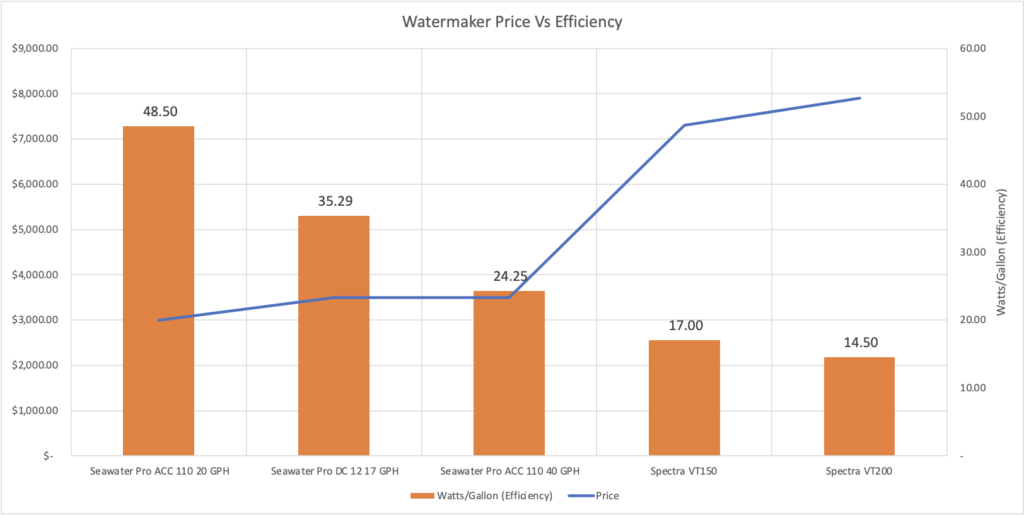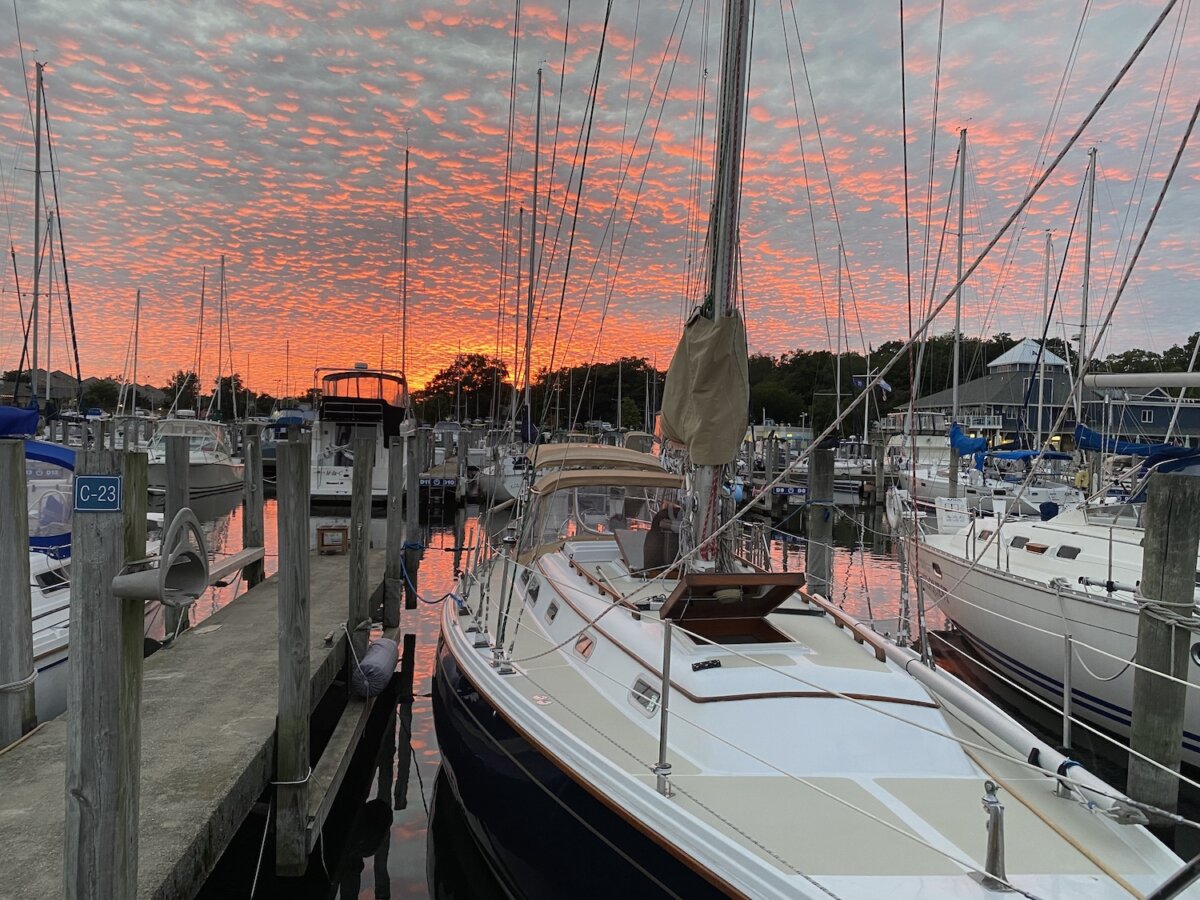As part of our refit on S.V. Resande, we have decided we want the ability to desalinate seawater to make our own water. Our goal is to disconnect as much as possible from the resources ashore, and water, like electricity is a critical utility to achieve that.
There are a several different options when considering a Reverse Osmosis desalination system. In this post, we’re going to look at offerings from two different companies: Seawater Pro and Spectra. Most watermakers are constructed similar to the Seawater Pro, it actually isn’t even that difficult to piece together your own kit as all the components are fairly easy to source.
One of the main considerations you need to keep in mind is the energy efficiency of your system. Electricity is another finite resource when cruising, and you need a robust system to power this process. Of the options we’re looking at, two are 110V AC powered and the other three are DC powered. It’s really important to understand whether your AC or DC system will be able to provide the needed electricity to the motors. We completely refit Resande’s electrical system, so the options we’re considering below will all work with our system. I’ll be comparing the five different models for their Price, Energy Efficiency, Output, Reliability, and Overall Size
Cost is an important factor that will influence your decision. All of these options are a large investment when refitting a boat, and money is always a constraint. Cost is especially when you consider it’s inverse relationship with energy efficiency: generally speaking, the more you pay, the more efficient your system will be. Below is a table of the five units we’re looking at, pricing is as of December 2022: Winner: Seawater Pro 40 GPH
| Model | Price | Gallons/ Hour (GPH) | Cost per Gallon-Hour |
| Seawater Pro ACC 110 20 GPH | $ 2,995.00 | 20 | $ 149.75 |
| Seawater Pro DC 12 17 GPH | $ 3,495.00 | 17 | $ 205.59 |
| Seawater Pro ACC 110 40 GPH | $ 3,495.00 | 40 | $ 87.38 |
| Spectra VT150 | $ 7,300.00 | 6.3 | $ 1,158.73 |
| Spectra VT200 | $ 7,900.00 | 8.3 | $ 951.81 |
Energy Efficiency Just like money, electricity is another finite resource on a boat. Cruising is all about managing your resources. Once you’ve determined if your electrical system is capable of running each option, you need to look at the differences in efficiency. The easiest way to do this is to bring it down to a comparable metric, in this case Watts Per Gallon. I pulled the specs off these models to give rough estimates of the efficiency you can expect from each. The unique thing about the Spectra watermakers is their low energy consumption. Spectra does this by reclaiming some of the pressure with what’s called a Clark pump. It’s impressive that you can desalinate water for 120 watts or less, which should be easily handled by most unmodified electrical systems. They are by far the most efficient option, but you do pay for it in up front costs. Winner: Spectra models
| Brand | Model | Gallons/ Hour (GPH) | Watts | Watts/Gallon (Efficiency) |
| SeaWater Pro | Seawater Pro ACC 110 20 GPH | 20 | 970 | 48.50 |
| SeaWater Pro | Seawater Pro DC 12V 17 GPH | 17 | 600 | 35.29 |
| SeaWater Pro | Seawater Pro ACC 110 40 GPH | 40 | 970 | 24.25 |
| Spectra | Spectra VT150 | 6.3 | 107 | 17.00 |
| Spectra | Spectra VT200 | 8.3 | 120 | 14.50 |
Cost Vs. Efficiency: as I mentioned before, cost and efficiency have an inverse relationship with these watermakers. The graph below helps illustrate the relationship between up front cost and watts per gallon

Output is important to understand how much time it takes to fill your tanks. The options we’re looking at here vary from 6.3 GPH to 40 GPH. Resande has 80 gallons of water, which would take anywhere from nearly 13 hours to only 2 hours to fill from completely empty. In some ways, output is irrelevant, and you should focus on efficiency since time itself isn’t typically a constraint. You likely aren’t using 80 gallons per day, and you could use the Spectra option for one hour per day to replace your daily consumption. On the other hand, I could see us running the watermaker during peak sunlight hours, where we’re putting nearly 500+ watts of solar to take some of that load off the stored energy in the battery bank. During our shakedown trip in Summer 2022 to South Manitou, we proved out our electrical system with only 350 watts of solar installed. With the weather we had, our batteries were regularly topped off from the night’s consumption by around noon each day, and any additional sunlight was just going to waste the rest of the day. It would be great to convert that to water. Winner: Neutral/Depends on tankage and usage
Reliability I will preface this by saying I have heard nothing negative about the reliability of the Spectra watermakers. That being said, the Spectra Clark pump and spare parts are proprietary and therefore not easily replaceable. If you’re in a remote island, you’re probably not getting your watermaker fixed anytime soon. The Seawater Pro, uses simple and common components that a fellow cruiser may even have. Winner: Seawater Pro models
Overall Size: On a boat, the space required for additional equipment always needs to be a consideration. The Seawater Pro 40 GPH for example has two large 40″ membranes and a high pressure pump with motor. The Spectra however uses a 20″ membrane and it’s all packaged with the Clark pump to be one compact unit. Either one will require space, and depending on the available space one option may be easier to install than the other. You will want to make sure it’s physically located near the main positive bus bar since you’ll likely be pulling heavy amperage (needing heavy gauge wiring) with the Seawater Pro options. The Spectra options would give significantly greater flexibility due to their size, shape, and lower current draw.
Deciding between Seawater Pro models: As of right now, we’re deciding between the three Seawater Pro options.
- The 20 GPH model makes the least sense on paper, however you could easily upgrade it to 40 GPH in the future just by buying an additional membrane. It’s the cheapest option, and smaller than the 40 GPH in our space constraints
- The 17 GPH model is more efficient than the 20 GPH option, but a bit pricier. Apples to apples with the 20 GPH it’s probably worth the additional $500. It has a lower current draw at 600W (50 Amps) and runs directly off DC, so you don’t have to worry about involving the inverter to make water.
- The 40 GPH option is the same price as the DC 17 GPH option, but you get 2.3X the output. You do have to deal with a second membrane and it’s the highest efficiency of the three Seawater Pro options
March 2023 Update: We just received our watermaker yesterday. We ended up going with the 17 GPH DC Powered Seawater Pro model. We also added in the control panel since we wanted to do it right, do it once, and the extra cost would be offset by the countless times we’d be able to avoid ripping apart our aft to operate it in the future.
One more option: at nearly the last minute, we strongly considered going with the Sun Pure Watermaker option, which is very similarly priced and spec’d to the Seawater Pro. The nice thing about it was it’s local here in Michigan, so we’d be able to support a local business and save money on shipping. We still ended up going with Seawater Pro because the quality of the plumbing fittings and flush system looked slightly higher and more importantly the membrane housing is reinforced with the stainless steel rods (2:00 on this video) which help protect from hydraulic shock that can happen, specifically on a boat.
Please leave a comment below letting us know what you would do!


